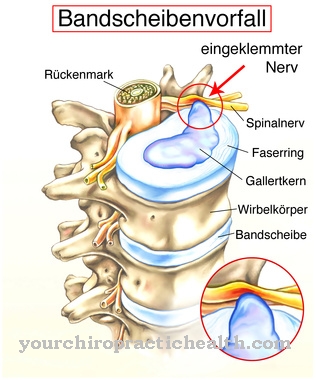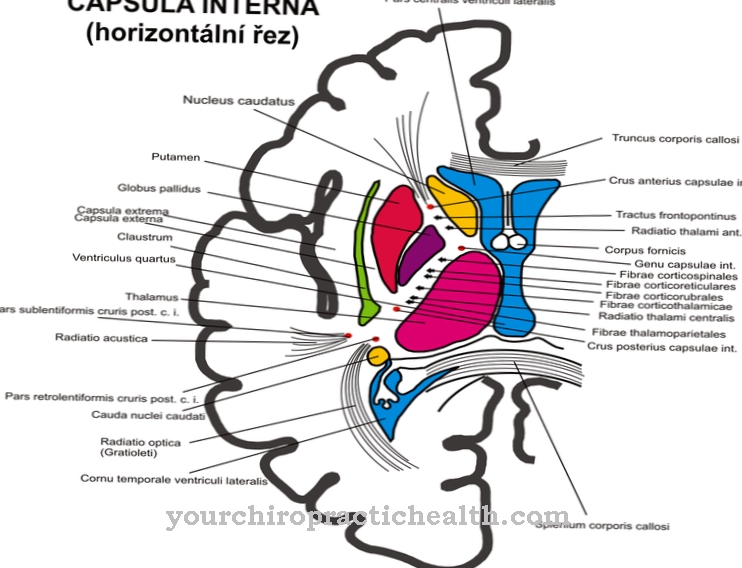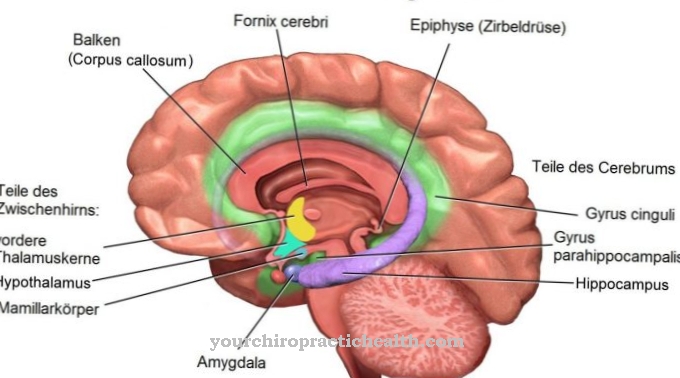Of the Hypoglossal nerve is the twelfth cranial nerve. The motor nerve innervates the tongue muscles. When the nerve is paralyzed, speech and swallowing disorders occur.
What is the hypoglossal nerve?
The tongue is a muscular organ covered with a mucous membrane. As such, it is involved in everyday human life with innumerable movements. Humans need the tongue and its flexibility for communication, for example. Tongue movements are vital in the context of eating.
The mobility of the tongue is ensured by a motor nerve that connects the muscle to the central nervous system and transmits voluntary motor commands to it in the form of excitation. This motor nerve is that of the hypoglossal nerve.
In Greek, "hypoglossus" means something like "under the tongue". The hypoglossal nerve corresponds to the twelfth and last cranial nerve. Like all cranial nerves, the hypoglossal nerve also arises directly from the specialized clusters of nerve cells or cranial nerve nuclei within the brain. In addition to the tongue muscle, the nerve with its fibers also innervates the floor of the throat.
Its nucleus is called the nucleus nervi hypoglossi and lies paramedian and elongated on both sides in the caudal part of the medulla oblongata and on the bottom side of the fossa rhomboidea in the trigonum nervi hypoglossi. This point is at about the same level as the nuclei of cranial nerves ten and eleven.
Anatomy & structure
The hypoglossal nerve emerges from the medulla oblongata lateral to the pyramid with its up to twelve root fibers. From there it extends on the brain surface in about three trunks to the canalis nervi hypoglossi on the os occipitale, where it leaves the cranial cavity near the foramen magnum. The motor nerve runs outside the skull between the internal jugular vein and the internal and external carotid arteries. In the carotid trigonum, ventral branches from the upper cervical nerves attach to the nerve.
Some of the fiber strands accompany the hypoglossal nerve in order to partially innervate the hyoid muscles. All other fibers of the nerve bend at the cranial carotid trigonum, from where they continue to the submandibular trigonum under the stylohyoid muscle and venter posterior of the digastric muscle. At this point, they enter the muscles of the tongue from the side of the floor of the mouth between the mylohyoideus and hyoglossus muscles.
Like all motor nerves, the hypoglossal nerve is in contact with the motor endplate of the target muscle. In the case of the twelfth cranial nerve, the target muscle corresponds to the external and internal tongue muscles. In addition to the efferent fibers, the nerve contains afferent fibers from the muscle spindle and Golgi tendon organ within the tongue. The twelfth cranial nerve supplies the musculus longitudinalis superior and inferior, the musculus verticalis linguae and transversus linguae and the external tongue muscles musculus chondroglossus, genioglossus, hyoglossus and styloglossus
Function & tasks
Motor nerves such as the hypoglossal nerve transmit signals from the central nervous system to the muscle fiber via the motor endplate of their target muscles. With this signal transmission, the muscles are moved into a contraction. The motor nerves are known as efferent fibers because of their direction in which they conduct excitation, as they lead away from the central nervous system.
Via the afferent sensory fibers from the Golgi tendon organ and the muscle spindle of the tongue, the hypoglossal nerve, despite its predominantly efferent motor fibers, conducts stimulus perception from the tongue muscle towards the central nervous system. These stimulus perceptions primarily convey the current muscle tone to the nervous system. Only with this information can targeted voluntary movements of the tongue occur, which allow a precise change of the muscle tone.
The described functions are taken over by the nerve for the musculus longitudinalis superior and inferior, the musculus verticalis linguae and transversus linguae and the external tongue muscles musculus chondroglossus, genioglossus, hyoglossus and styloglossus. The nerve is involved in almost all tongue movements.
In addition to crushing food, the act of swallowing and the formation of sounds depend on the position of the tongue. As a result, the hypoglossal nerve is irreplaceable for everyday human life and communication. Since linguistic communication is sometimes referred to as a specific human species, the nerve and its functions in communication make a significant contribution to typical human characteristics.
You can find your medication here
➔ Medicines for sore throats and difficulty swallowingDiseases
If the hypoglossal nerve is damaged on one side, it results in unilateral tongue paralysis. The tongue deviates to the damaged side. This leads to speech disorders and difficulties in consuming food and fluids. Since one-sided paralysis can be compensated relatively well by the other side, this damage is usually not perceived as a severe handicap. The paralyzed side of the muscles breaks down over time. So paretic atrophy occurs.
Serious problems in everyday life occur when the hypoglossal nerve is damaged on both sides. This phenomenon leads to complete paralysis of the tongue, in which the entire tongue muscles atrophy over time. In the case of bilateral paralysis, the tongue remains motionless on the floor of the throat, resulting in the most severe speech disorders and severely impaired food and fluid intake.
People with bilateral paralysis of the twelfth cranial nerve also run the risk of inhaling their own saliva, so that severe pneumonia is a common consequence.
Unilateral paralysis can result from diseases such as multiple sclerosis or a stroke. For example, bilateral paralysis occurs at a certain stage in ALS. In an apoplexy (stroke) in the sense of a cerebral blood flow disorder, only partial functional disorders of the hypoglossal nerve usually occur.



























